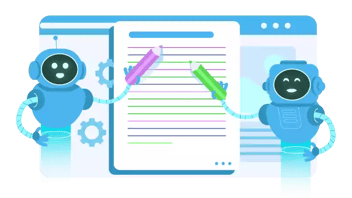Balise hreflang : Définition et usage en SEO multilingue
Imaginez un monde où votre site web parle toutes les langues. Des clients du monde entier découvrent votre marque en naviguant de manière transparente dans votre contenu dans leur langue maternelle. Telle est la puissance du référencement multilingue.
La balise hreflang peut être votre arme secrète pour conquérir la recherche internationale.

Qu'est-ce que la balise hreflang ?
La balise hreflang, souvent exprimée par rel="alternate" hreflang="x", est un attribut HTML crucial conçu pour communiquer la langue et le ciblage régional d'une page web spécifique. C'est un signal pour les moteurs de recherche, en particulier Google, qui les informe des variations linguistiques disponibles pour une page.
La volonté de Google de fournir des résultats de recherche personnalisés et pertinents s'aligne parfaitement sur l'objectif de l'attribut hreflang. En mettant en œuvre les balises hreflang, les propriétaires de sites web fournissent des instructions explicites au moteur de recherche, lui permettant de comprendre les nuances linguistiques et les préférences de leur public cible. Cette collaboration entre les propriétaires de sites web et Google favorise une expérience de recherche plus personnalisée et centrée sur l'utilisateur.
La syntaxe de l'attribut hreflang est un modèle de communication efficace entre les sites web et les moteurs de recherche. L'attribut "rel" indique la relation entre les différentes versions linguistiques d'une page, tandis que l'attribut "hreflang" spécifie la langue et le ciblage régional facultatif. Par exemple, "en" peut représenter l'anglais, "es" l'espagnol et "fr-ca" le français canadien. Cette syntaxe structurée agit comme une feuille de route linguistique pour les moteurs de recherche, les aidant à fournir du contenu aux utilisateurs dans la langue et la région qu'ils préfèrent.
L'avantage principal de l'incorporation des balises hreflang réside dans l'amélioration significative de l'expérience de l'utilisateur. Lorsque les utilisateurs effectuent des recherches dans une langue spécifique, des attributs hreflang bien implémentés garantissent qu'ils sont dirigés vers la version de la page web la plus pertinente et la plus appropriée d'un point de vue linguistique. Cette précision favorise la satisfaction de l'utilisateur et contribue à réduire les taux de rebond et à augmenter l'engagement, ce qui, en fin de compte, renforce les performances du site web en matière de référencement.
Quand et pourquoi utiliser les balises hreflang ?
Le ciblage multilingue et le ciblage international peuvent sembler synonymes, mais ils ont des implications distinctes en matière de référencement. Le ciblage multilingue implique la présentation du contenu dans différentes langues, tandis que le ciblage international va au-delà de la langue pour inclure des variations basées sur les régions ou les pays. Les balises hreflang deviennent indispensables dans ces scénarios, aidant les moteurs de recherche à fournir avec précision un contenu adapté aux préférences linguistiques et régionales.
Les balises Hreflang sont particulièrement importantes lorsqu'un site web propose un contenu dans plusieurs langues ou dialectes régionaux. Les plateformes de commerce électronique, les entreprises internationales et les établissements d'enseignement qui s'adressent à des publics linguistiques divers ont tout à gagner d'une mise en œuvre précise des balises hreflang. En outre, les organes d'information et les éditeurs qui diffusent des contenus d'intérêt mondial ont tout intérêt à s'assurer que les utilisateurs reçoivent les informations les plus pertinentes d'un point de vue linguistique.
Si l'attribut hreflang est un puissant allié du référencement, son efficacité dépend de sa précision. Des balises hreflang incorrectes ou manquantes peuvent conduire à une mauvaise orientation des utilisateurs, ce qui dilue l'impact de la stratégie multilingue. Il est important d'être attentif aux pièges tels que les codes de langue non concordants, un ciblage régional inapproprié ou une mise en œuvre incomplète.
Comment mettre en œuvre les balises hreflang
La mise en œuvre correcte des balises hreflang est essentielle pour exploiter pleinement le potentiel du référencement multilingue.
Incorporation des balises hreflang dans le code HTML
-
Identifier les langues et régions cibles : Déterminez les langues et les régions que votre site web vise à cibler. Il est essentiel de comprendre les préférences linguistiques de votre public.
-
Incorporer la balise hreflang dans la section "head" du code HTML : Placez les balises hreflang dans la section "head" du code HTML. Pour chaque langue ou variation régionale, utilisez la syntaxe suivante :
-
link rel="alternate"
-
hreflang="en"
-
href="https://example.com/en/page"
-
-
Inclure des balises d'autoréférencement : Veillez à ce que chaque page comporte une balise hreflang autoréférencée et indiquez la langue ou la région par défaut :
-
ink rel="alternate"
-
hreflang="x-default"
-
href="https://example.com/default/page">
-
-
Mise en œuvre cohérente sur l'ensemble des pages : Veillez à la cohérence de la mise en œuvre de la balise hreflang sur toutes les pages, afin de renforcer le signal envoyé aux moteurs de recherche concernant les variations linguistiques disponibles.
-
Utiliser des balises canoniques : Utilisez les balises canoniques en conjonction avec les balises hreflang pour spécifier la version préférée d'une page, minimisant ainsi les problèmes de contenu dupliqué.
Utilisation de hreflang dans les cartes de site XML
-
Générer des sitemaps XML multilingues : Créez des sitemaps XML distincts pour chaque langue ou version régionale de votre site web. Cela améliore la clarté pour les robots d'indexation des moteurs de recherche.
-
Inclure des annotations hreflang : Dans chaque sitemap XML, incorporez des annotations hreflang pour les pages individuelles. Cela renforce l'association entre les pages et les langues ou régions ciblées.
-
Soumettre les sitemaps aux moteurs de recherche : Soumettez les sitemaps XML multilingues aux moteurs de recherche via leurs outils de webmaster respectifs. Cela facilite une indexation efficace et garantit que les versions linguistiques correctes sont affichées dans les résultats de recherche.
Bonnes pratiques pour l'établissement de liens vers des versions linguistiques alternatives
-
Navigation claire et conviviale : Concevoir une structure de navigation claire et conviviale qui facilite les transitions entre les différentes versions linguistiques. Utilisez des menus déroulants, des drapeaux ou des sélecteurs de langue pour améliorer l'accessibilité.
-
Utiliser un texte d'ancrage descriptif : Lorsque vous créez des liens vers d'autres versions linguistiques, utilisez un texte d'ancrage descriptif qui reflète la langue ou la région afin de clarifier les choses pour les utilisateurs et les moteurs de recherche.
-
Évitez les plugins de traduction automatique : Bien que tentants, les plugins de traduction automatique peuvent ne pas mettre en œuvre correctement les balises hreflang. Optez pour des services de traduction professionnels ou mettez en œuvre manuellement les balises hreflang pour un ciblage linguistique précis.
-
Conception réactive pour les utilisateurs mobiles : Veillez à ce que la mise en œuvre des balises hreflang s'étende aux versions mobiles de votre site web, afin d'offrir une expérience multilingue cohérente aux utilisateurs sur différents appareils.
Outils et ressources pour la mise en œuvre de hreflang
-
Google Search Console : Surveillez régulièrement le rapport "Ciblage international" dans Google Search Console afin d'identifier et de rectifier tout problème lié à la mise en œuvre des balises hreflang. Cet outil permet de savoir comment Googlebot interprète et indexe vos annotations hreflang.
-
Outils de test hreflang : Utilisez des outils en ligne tels que l'outil de test hreflang fourni par Google pour vérifier l'exactitude de vos balises hreflang. Ces outils identifient les erreurs potentielles et garantissent aux utilisateurs une expérience multilingue transparente.
-
Service de validation des balises du W3C : Utilisez le service de validation des balises du W3C pour valider la syntaxe HTML de vos balises hreflang, afin de garantir la conformité avec les normes du web. Les annotations linguistiques dans les attributs hreflang doivent être conformes au format ISO 639-1, et les annotations locales (facultatives) doivent être conformes au format ISO 3166-1 Alpha 2.
-
Outils d'audit SEO: Des outils tels que SEMrush, Moz et Ahrefs peuvent contribuer à des audits SEO complets et aider à identifier les problèmes liés aux balises hreflang, en fournissant des informations exploitables pour améliorer votre stratégie de référencement multilingue. Audit SEO pour votre site web
En suivant méticuleusement ces étapes et en intégrant les meilleures pratiques, les propriétaires de sites web peuvent exploiter la puissance des balises hreflang pour créer une présence web multilingue harmonieuse et efficace.
Problèmes courants liés aux balises hreflang
Lorsque l'on utilise des outils d'audit comme ahrefs site audit, on voit souvent les problèmes hreflang suivants identifiés :
Absence de hreflang réciproque (pas de return-tag)
Il manque des liens de confirmation (retour) pour les pages déclarées dans les annotations hreflang. Si la page A renvoie à la page B dans les annotations hreflang, la page B doit renvoyer à la page A en retour. Si ce n'est pas le cas pour toutes les pages qui utilisent les annotations hreflang, ces annotations peuvent être ignorées ou mal interprétées.
Ce problème peut également être déclenché par une mauvaise utilisation de hreflang "x-default". Lorsque la valeur facultative "x-default" de hreflang est utilisée, toutes les pages du groupe hreflang doivent faire référence à la même page "par défaut".
Solution : pour résoudre ce problème, assurez-vous que toutes les versions de pages traduites ou destinées aux utilisateurs d'une certaine région possèdent le même ensemble d'annotations hreflang, qui comprend les URL de toutes les versions de pages. Cela permettra de toujours fournir des liens de retour entre les pages alternatives.
Annotation hreflang par défaut manquante
Pages sans annotation hreflang par défaut. Un ensemble d'annotations hreflang sur les multiples versions de votre page traduites ou destinées aux utilisateurs d'une certaine région doit inclure un attribut hreflang x-default.
x-default sera utilisé pour toute autre langue (ou langue et emplacement) non spécifiée dans un ensemble d'annotations hreflang.
Comment y remédier ? Assurez-vous que chaque page de votre site web possède un attribut hreflang x-default qui pointe vers une page non spécifique à une langue ou à une région.
Pour plus d'informations, consultez les instructions de Google sur la mise en œuvre de l'attribut hreflang.
Mesurer le succès des balises hreflang
La réussite du référencement multilingue est incomplète si l'on ne dispose pas d'une solide stratégie de mesure. Une mesure efficace commence par la définition et le suivi des bons indicateurs clés de performance. Pour le référencement multilingue, les indicateurs clés sont les suivants
-
Le trafic organique par langue : Surveiller le trafic organique à partir des différentes versions linguistiques pour évaluer l'engagement du public.
-
Classement des mots-clés dans les différentes langues : Évaluer le classement des mots-clés ciblés dans différentes langues afin de garantir la visibilité sur divers marchés de recherche.
-
Taux de rebond par langue : Analysez les taux de rebond par langue pour vérifier l'efficacité de la pertinence du contenu pour chaque segment d'audience.
-
Taux de conversion par langue : Suivez les taux de conversion pour les différentes versions linguistiques afin d'évaluer l'impact sur les objectifs de l'entreprise.
Google Search Console permet d'évaluer l'efficacité du hreflang. Le rapport "Ciblage international" de la Search Console donne un aperçu de la manière dont Google interprète et exécute les annotations hreflang. Il met en évidence les erreurs ou les problèmes potentiels, ce qui permet de prendre rapidement des mesures correctives. En outre, le suivi de l'état de l'indexation, des erreurs de crawl et des analyses de recherche pour chaque version linguistique permet d'affiner la stratégie hreflang sur la base de données en temps réel.
Les balises hreflang sont plus que de simples éléments techniques ; elles favorisent la connexion, font tomber les barrières linguistiques et amplifient l'expérience des utilisateurs. Alors que les entreprises reconnaissent l'importance de parler la langue de leurs différents publics grâce à des sites web multilingues, les balises hreflang apparaissent comme des outils indispensables pour favoriser la réussite internationale.
Ce contenu est disponible en:
- Allemand: Hreflang-Tag: Was es ist & Anwendung in mehrsprachiger SEO
- Anglais: What is the hreflang Tag, and How Do I Use it in Multilingual SEO?
- Espagnol: ¿Qué es la etiqueta hreflang y cómo se utiliza en el SEO multilingüe?
- Italien: Cos'è il tag hreflang e come si usa nella SEO multilingue?
- Roumain: Ce este eticheta hreflang și cum o folosesc în SEO multilingv?
- Chinois: 什么是 hreflang 标签,如何在多语言搜索引擎优化中使用?

Joachim, formateur certifié HubSpot avec plus de 13 ans d'expérience en marketing de contenu, stratégie, déploiement de sites web et SEO, a mis en œuvre de nombreuses missions de growth marketing internationales à grande échelle, par exemple avec UiPath, de son statut de startup à son introduction en bourse (IPO) au NYSE. Joachim possède une expertise particulière dans les missions de marketing multilingue et d'aide à la vente (Sales Enablement), en tirant parti des technologies d'IA de pointe pour nos clients.





.webp?width=352&name=Blog_WBM_Platforms%20for%20Engaging%20Your%20Audience%20(1).webp)


Commentez ci-dessous